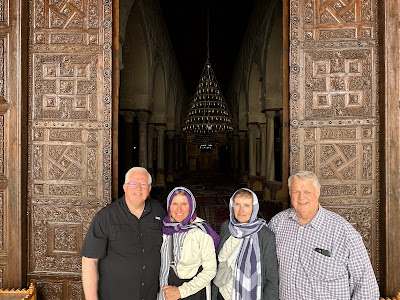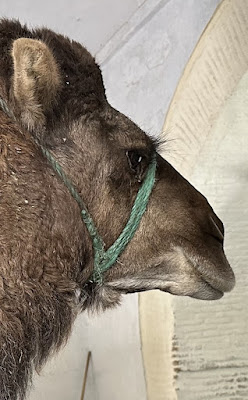March 21, 2014
After a non-descript buffet breakfast in the hotel, our guide Feker picked us up at our hotel. This is the courtyard in front of our hotel, accessed by a wonderful stone gate.
A sign on the gate says a whole bunch of stuff in Arabic, and Porte de France, 13/03/1912 in French.
The gate marks the separation between the old medina and the new city.From our room's balcony, which overlooked the square, I had seen a man strewing seed in the plaza. There were plenty of pigeons there scavenging for leftovers about half an hour later.
It is always interesting to drive through a capital city. We didn't really go through the business district, but we passed this wonderful clock tower nicknamed "Big Ben Ali," not just for its resemblance to London's famous clock, but also because it was erected in 2001 by the then dictator of Tunisia, Zine El Abidine Ben Ali.
This 23-second video shows what the area we were driving in looks like. I think we were still in or just outside Tunis at this point:
We stopped to pick up Feker's cousin, who acted as the guide for most of the day.
Feker drove a couple of hours along a somewhat bumpy road at high speeds to the 9th-century city of Kairouan.
We stopped along the way for Bob to look at olive trees and to see a food stand with a camel head hanging from a crossbar and a young camel staked nearby.
In Kairouan, we stopped at a museum ("La Ville De Kairouan") with a viewing platform that allowed us to get perspective on the surrounding city. In 860 the local ruler commissioned the building of two large pools or reservoirs of water, now called the Aghlabid Basins, to serve the population. Water was brought in by canals and aquaducts. Only one of the two reservoirs is still visible, and it is full of water.
Domed buildings near the pool are mausoleums.
Here is the Tunisian flag:
I was struck by its resemblance to the Turkish flag:
I never did write down Feker's cousin's name, but he knew a lot about everything. However, he was harder to understand than Feker and gave us WAY too much information--so much that it was hard to remember any of it when the day was over.
Looking up at the observation deck from below.
We drove a few more minutes and parked near the entrance to the medina:
The mosque is strategically located at the crossing point of fifteen different roads. It is considered the fourth holiest site in Islam behind Mecca, Medina, and Jerusalem.
After Chris and I donned headscarves (scar-fuz, as pronounced by Feker), we were allowed to go inside the courtyard. That's the four of us in the second photo . . .
No problem. There was a man there who for a few dinar would take our phones inside and take a few pictures for us!
We could also stand in front of the door to the mosque for a picture.
The massive minaret, added in the early 9th century, looms 31.5 meters (103.35 feet) above the courtyard.
Stones from Roman ruins were part of the building material for the mosque. Our guides showed us some stones that still have Latin words engraved on them. On some stones, the text is upside-down, indicating that the builders of this mosque didn't really care what they said, and probably couldn't read them, but valued them as building material.
Another beautiful doorway, maybe to a classroom? I don't remember.
After leaving the mosque, we headed to the souk, or marketplace. Could that be Simon and Garfunkel on a wall in the parking lot?
Initially, the streets were lined by slightly aggressive vendors on the hunt for gullible tourists.
Our guide took us up some stairs to a room where a harnessed camel walked in circles to turn a water wheel, which brought up water from a well.
A little further on we stopped at a Tunisian bakery where Feker encouraged us to try some fried sweets. "Sweets" is an understatement. They were probably the sweetest thing I've ever eaten. Ugh--too much.
But we ate them anyway, conscious that our guides were fasting for Ramadan.
Tunisia seems to be especially enamored with the color blue, perhaps because approximately three-quarters of the country is desert or near-desert.
While to us this looks like a lovely, romantic place to live, Feker told us that the younger generation does not want to live here. They prefer apartments in the cities where there are more opportunities and more things going on.
























































(Bob) I was a little disappointed with Kairouan. Being the 4th most holy site in Islam I was expecting it to have more grandeur, more hype, more bustle. The best part of the day for me, as far as what you've covered, was the camel meat store, with live camel in front and camel head and leg bone hanging from a roof. That was something I've never seen before and a fascinating cultural item. Of course, I would like to have partaken of some of the camel, but not enough time or place to do so.
ReplyDelete